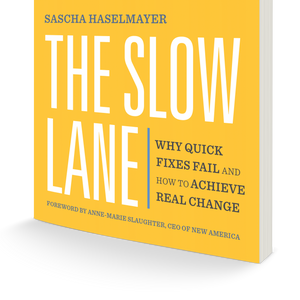Most people thought that homelessness was like a law of nature, an inevitable, if sad, fact of urban life. The Slow Lane came up with a different answer, one that is more audacious than even the most generously resourced homeless shelter: We should put an end to homelessness. Rosanne Haggerty, the President of Community Solutions—and one of the leaders behind this idea—has helped 14 communities reach so-called functional zero homelessness and is working with 91 more communities to reach zero. A few months ago, Ashoka hosted a conversation in which I asked Rosanne how the idea of ending homelessness became a possibility.
"We were providing shelter for people for up to 30 days when none of them had 30-day problems."
Here are some highlights from our conversation, with insights into how we can bring audacious ideas into the realm of possibility, by building trust, new practices and aligning everyone around a new common purpose.
The Conversation
Q: Rosanne, your story began with volunteering at a shelter and realizing that shelters weren't solving the real problems. Tell us what you saw.
Rosanne Haggerty: We were providing shelter for people for up to 30 days when none of them had 30-day problems. The good people running the shelter would explain, “Here are the cots, here's the coffee pot, here's the time the bus is going to be picking folks up.” But those experiencing homelessness would arrive and ask, “How do we find housing? Where do I apply?” I was struck by the mismatch between what people were seeking and the responses on hand.
Q: At what point did you realize it was possible to do things differently, to actually end homelessness?
Rosanne: More than ten years ago, my colleagues and I shifted course and started focusing on system connection issues, on helping communities build the operating systems needed to prevent and end homelessness, not simply help those experiencing homelessness to survive another day. Our earlier work had shown us a fundamental problem: it was no one’s job in any community to see that all the assistance on offer was adding up to fewer people experiencing homelessness in that place. Leaders in other communities were seeing the same problem and volunteered to work with us and as a group to learn what it would take to actually end homelessness. This gave rise to our Built for Zero network, which now includes more than 100 communities committed to reaching and maintaining functional zero.
"Communities at functional zero focus on the question, “is everything we’re doing adding up to fewer people experiencing homelessness?” The key ... is having public health-quality data."
Q: Could you explain this term, “functional zero” homelessness?
Rosanne: When a community reaches functional zero, it means that homelessness is rare and short-lived at the population level. Homelessness is a dynamic problem and is going to look different today than it did yesterday, as people go in and out of housing crises. But communities at functional zero have a tightly coordinated system in place around the shared aim of ending homelessness. They measure progress in the same way, at the population level, not program by program. They focus on the question, “is everything we’re doing adding up to fewer people experiencing homelessness?”
The key to this collaborative approach is having public health-quality data that can enable all the key organizations to see the same, comprehensive picture of homelessness, person by person, across the community, in real time. With that information local teams can see which practices and policies are leading to reductions in homelessness and which are not. That also allows them to see opportunities for improving everyone’s work through greater collaboration, and to rapidly test new ideas for preventing and resolving homelessness. These teams ask better questions as they’re able to see where their resources are having the most impact on reducing homelessness all the way to functional zero.
Q: Built for Zero now includes over 100 communities, with your team at the center. How do you support communities?
Rosanne: We start by helping a committed few people or groups gather the critical players: not-for-profit groups, city and county government, the housing authority, and the veteran affairs local office. These folks all have a piece of the information and resources needed to make progress toward functional zero, so we help them form a single, integrated team. Next, we help them gather and use the data they’ll need to have a complete and dynamic picture of homelessness across their community. We provide ongoing coaching in data analytics, quality improvement and other practices that support collaboration for results. This includes helping communities understand how to prevent homelessness, whether by collaborating with “upstream” systems like healthcare or using data to track and mitigate inflow into homelessness. And as no community should have to innovate alone, Built for Zero is also a robust peer network, with communities sharing pain points and learning from each’s successes.
"We’re so used to a community saying: we don't have enough housing, there’s nothing to be done. But now we have the evidence in more than a hundred places that you don't even know what housing you need."
Q: There are often assumptions that housing shortages are the real issue. Is that what you’re seeing?
Rosanne: Yes and no. We’re so used to a community saying: we don't have enough housing, there’s nothing to be done. But now we have the evidence in more than a hundred places that you don't even know what housing you need—or what barriers you've created inadvertently with your local policies—until you do the work of understanding the dynamics of homelessness in your community and getting better data on the nature of the problem. Plus, there are many different profiles of communities. Coastal communities that are very high cost, other communities that have lost population where housing cost and availability isn’t the same problem. There are other places where rents are deeply misaligned with local wages and are simply above what is attainable with a minimum wage job or typical wage, and not the availability of housing.
Getting specific in this way surfaces the need for a community to think of housing as a “system” that includes private landlords, government housing agencies, policies, and regulations that affect housing, finance, the process of building housing. We’ve created a Housing Systems team to help communities align these elements more effectively to reduce and end homelessness.

Q: What about faith communities, what role do they play?
"...how to transcend the ego and move from focusing on “my own program, my own shelter” to focus on achieving a shared, community-wide goal."
Rosanne: The faith community was the first responder to modern homelessness in America. Today, places like Fremont, Colorado last year ended veteran homelessness and it was an effort led by their faith communities. Abilene, Texas ended chronic and veteran homelessness and it's their faith communities that have mobilized different local resources, working toward justice and beyond charity. And you know, in some respects, the faith community informs our thinking about how to transcend the ego and move from focusing on “my own program, my own shelter” to focus on achieving a shared, community-wide goal.
Q: It feels like people are beginning to reject the that's-just-how-it-is mentality when it comes to this issue. This is quite something because homelessness is often seen as this endless problem.
"This work is about mutual commitments, shared accountability for results, constant learning and behaviors in service of a common aim."
Rosanne: I agree, we are seeing a shift. More communities are recognizing homelessness as a dynamic problem. In other words, you don’t just end it once. Solving homelessness means learning how to solve it every day. And as the issues shift over time—say there’s a fire at a large apartment building or a natural disaster like a flood—communities must dial up what they're doing. This reflects a mature understanding of problem-solving and recognizing that there is no silver bullet here. This work is about mutual commitments, shared accountability for results, constant learning and behaviors in service of a common aim.
Three Things That Make Audacious Ideas Possible
For people interested in practicing real change, Rosanne's story holds lessons not about ending homelessness. In her movement, three levels of action play together that can help us all create audacious ideas, missions, and practices others want to be part of.
1/ Earn the Trust: Over decades, Rosanne and her team have built a network of trust. Her team earned this trust from community leaders and funders by listening, caring and supporting their efforts. Community leaders, like the faith communities, themselves spent decades earning the trust of vulnerable people by caring and listening to them. With time, they came to define a bold new mission and shared commitment under Built for Zero: To end chronic homelessness in their community.
2/ Build the Craft: Over time, the movement developed a set of methodologies, backed by science, to collect real-time information about each person experiencing homelessness, and how long it takes to house them. It's the culmination of Rosanne's decades long goal to support people with what they actually need. The secret to success here is that the movement is quite prescriptive about how communities collect information about what people need, and how they keep track of their results and stay accountable. The how remains flexible, members of the movement sharing experiencing and tailoring solutions that work in their community.
3/ Change the Broken Mindsets: Behind every broken system, there is a broken mindset. Built for Zero is relentlessly campaigning to correct false assumptions that help justify the status-quo and stop local leaders from taking action to end homelessness. These include prevailing beliefs that “Homelessness is inevitable, it cannot be ended”, “We don't have enough housing”, “People experiencing homelessness come from outside our community” or “People experiencing homelessness have mental health and substance abuse issues that make them dangerous” (Read more here).



